Abstract
Peripheral blood leucocytes from multiple sclerosis (MS) patients and from normal individuals were tested for their interferon (IFN) producing capacity after stimulation in vitro with various lectins and viruses. The lectins, Con A, PHA and PWM, induced IFN-gamma. In a kinetic study, the response to Con A revealed itself as an all or none event: the number of responding cultures increased with increasing mitogen dose, but the IFN yield in responding cultures did not differ significantly between dose levels. Thus, any patient or donor could easily be rated as a responder or non-responder. About 1/2 of the MS patients were found to be non-responders if Con A or PHA were used as stimuli. Ninety per cent of the normal donors on the other hand were responders. With PWM as a stimulus 100% of both the MS patients and normal donor groups were found to be responders. Also, with PWM very small doses were sufficient to obtain a 100% response rate among tested cultures, and IFN production persisted for 5 days, while with Con A or PHA it was arrested after 2-3 days. The results indicate that the MS associated lesion is not the absence of functional impairment of all IFN-gamma producing cells, but in only a fraction of them or in an accessory cell population required for the response to Con A and PHA but not to PWM. Newcastle disease virus (NDV) and vesicular stomatitis virus (VSV) both induced IFN-alpha. With NDV as the inducer response rates were 100% and yields were high irrespective of whether the cells were derived from patients or control donors. In contrast, with VSV as the inducer lower response rates were found in cultures from MS patients than in those from controls.
Full text
PDF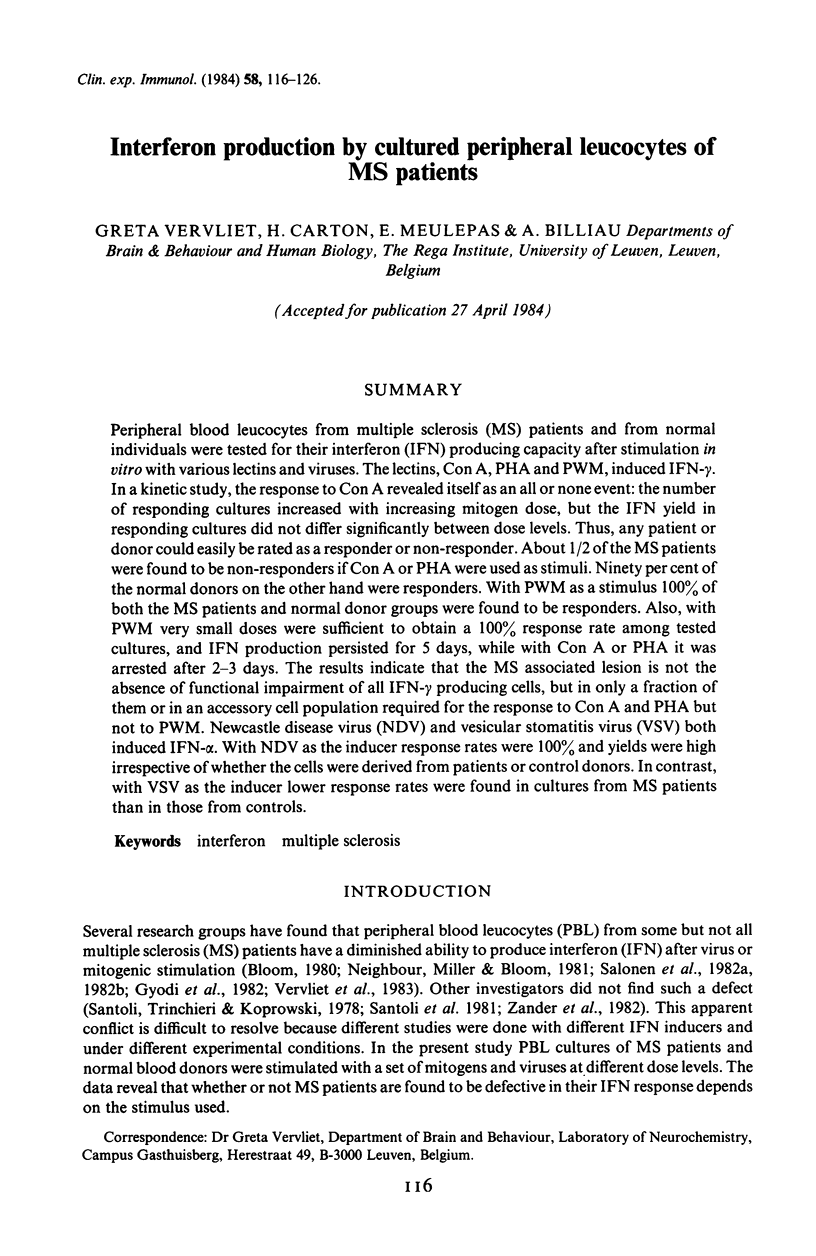
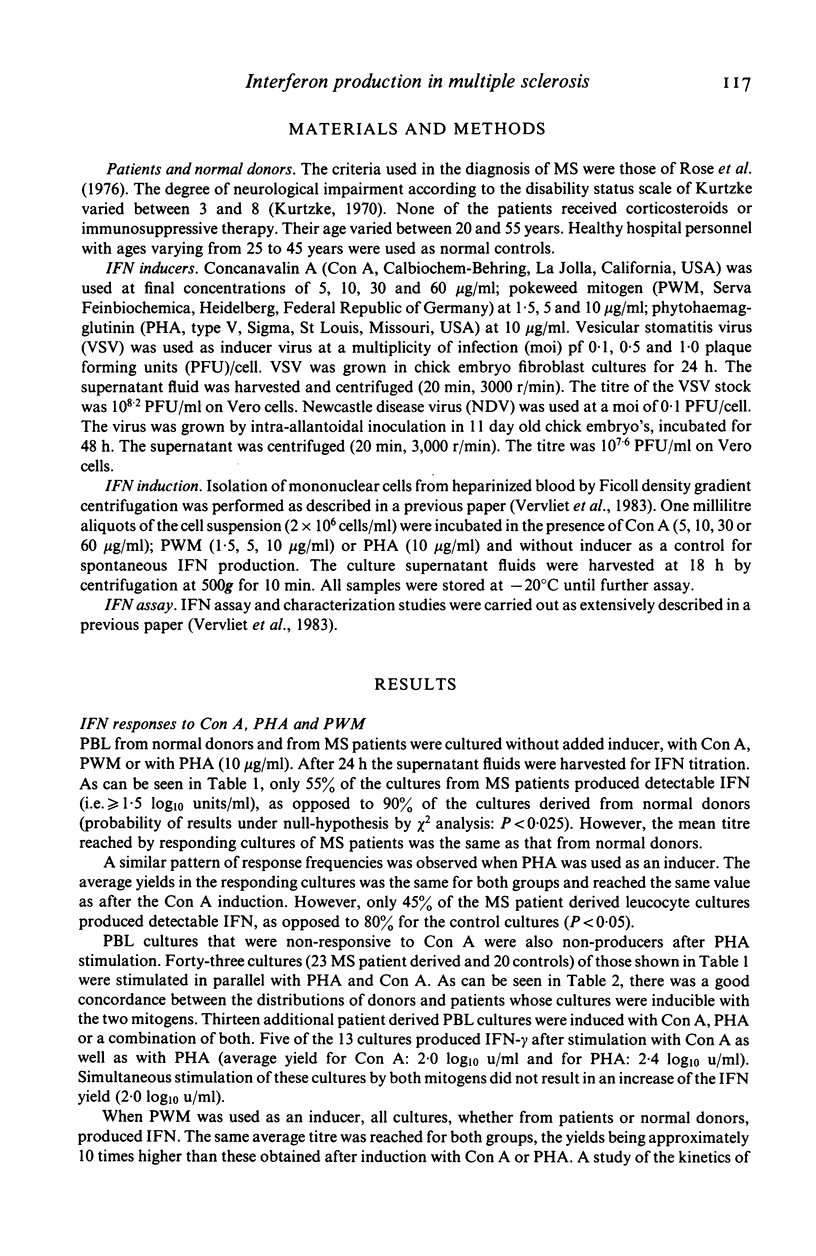
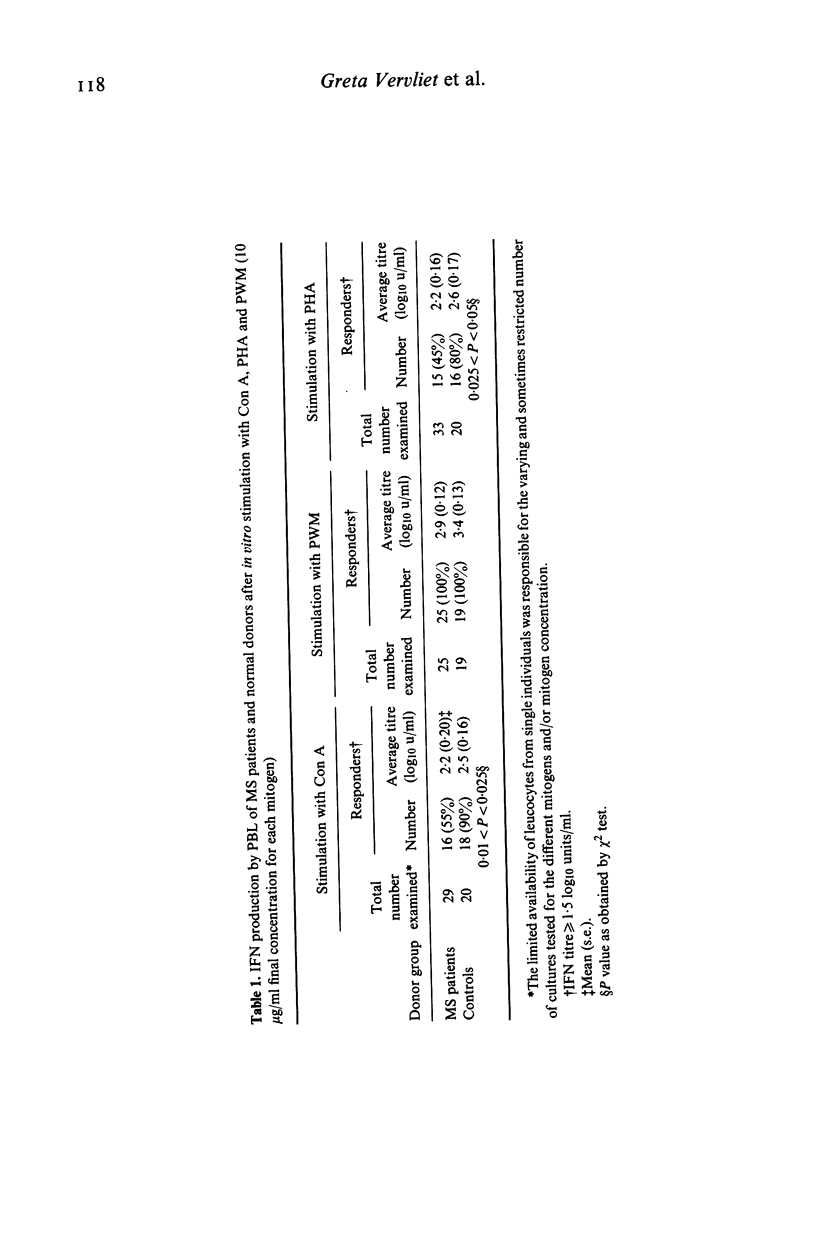
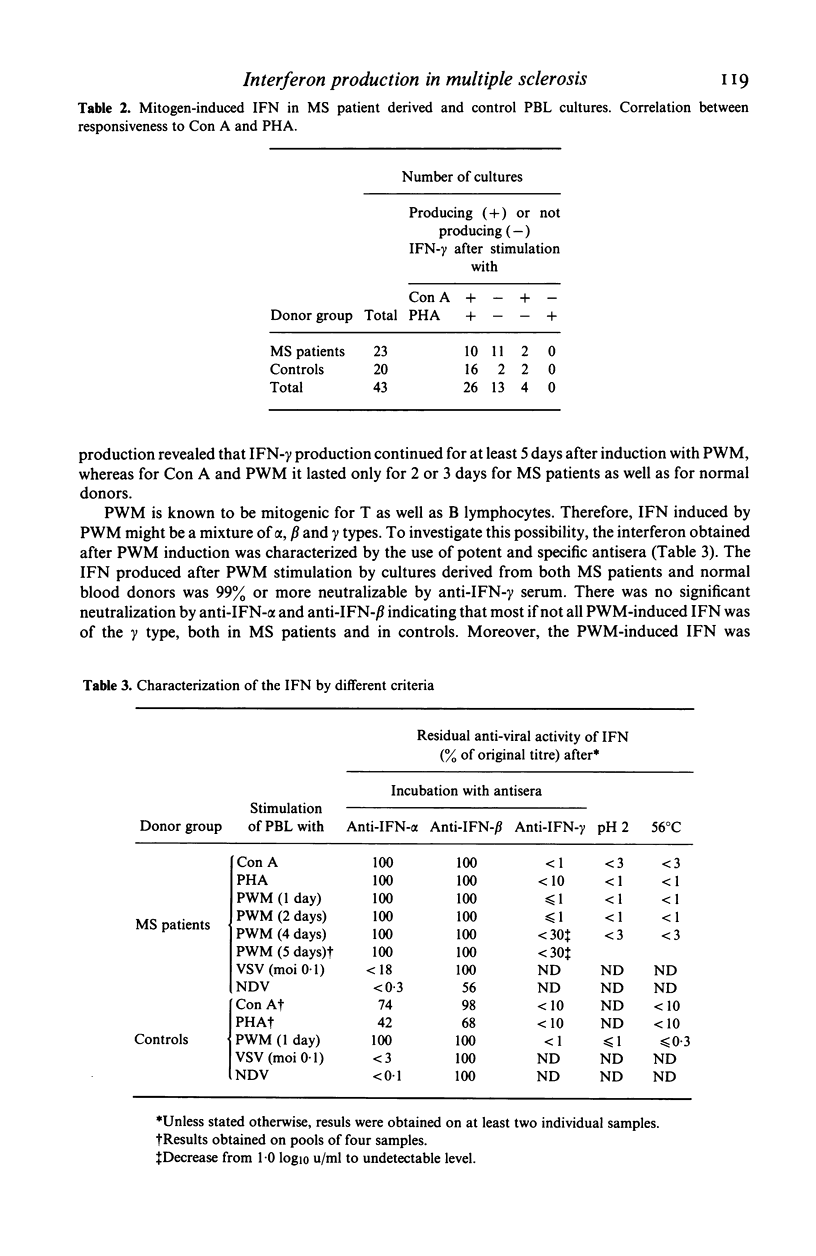
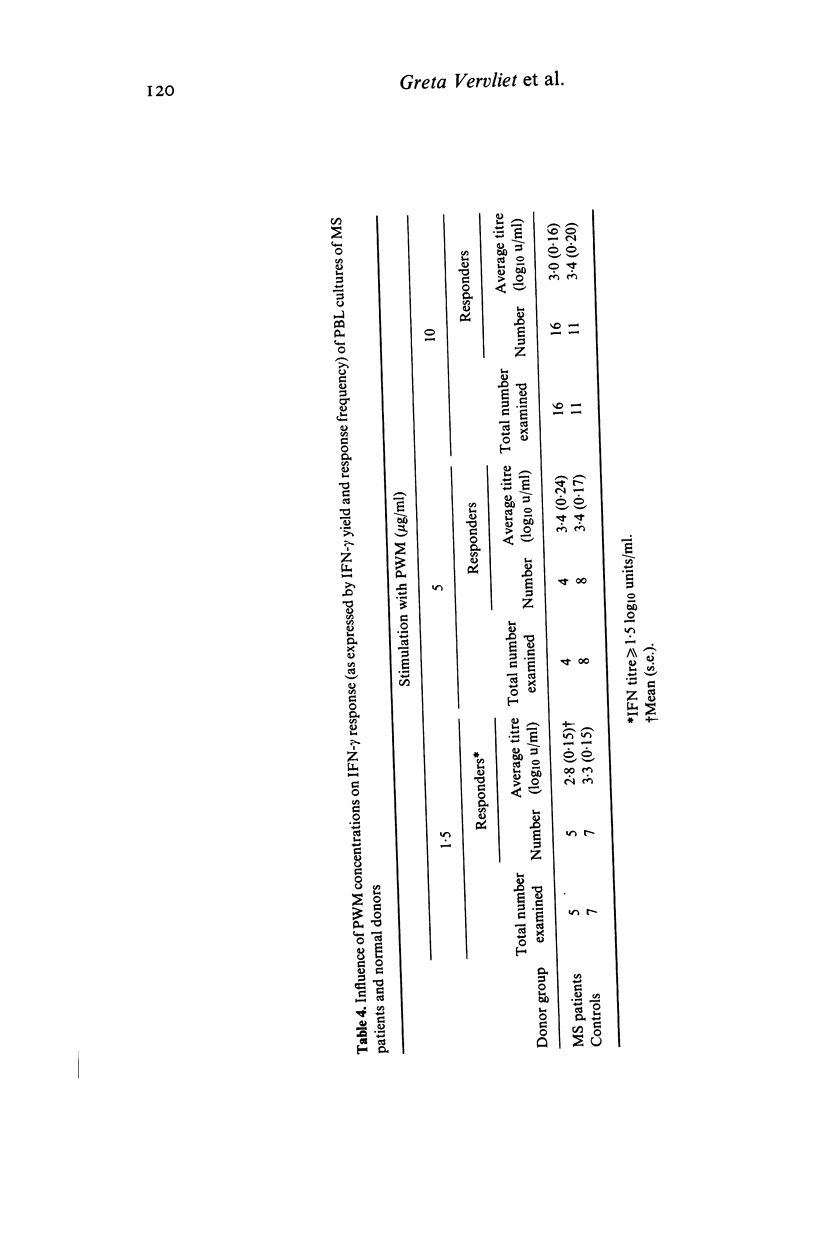
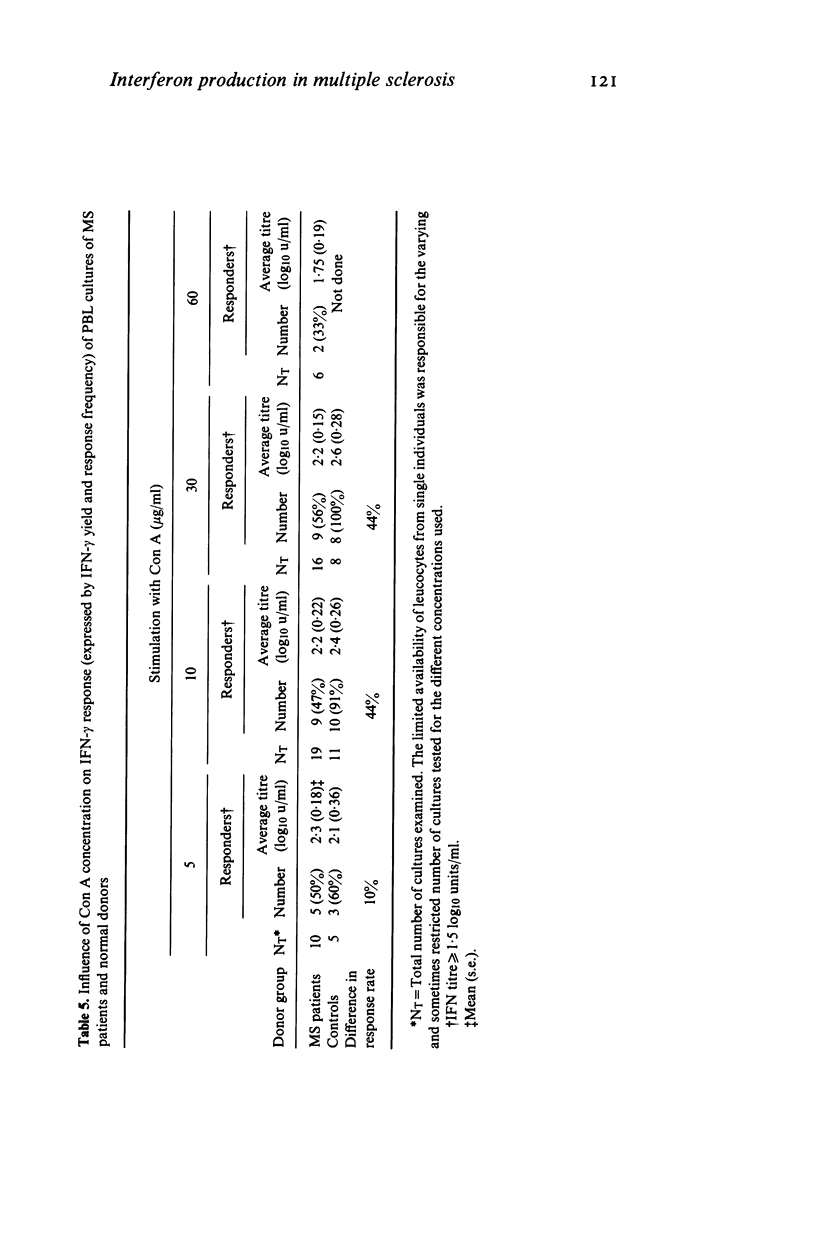
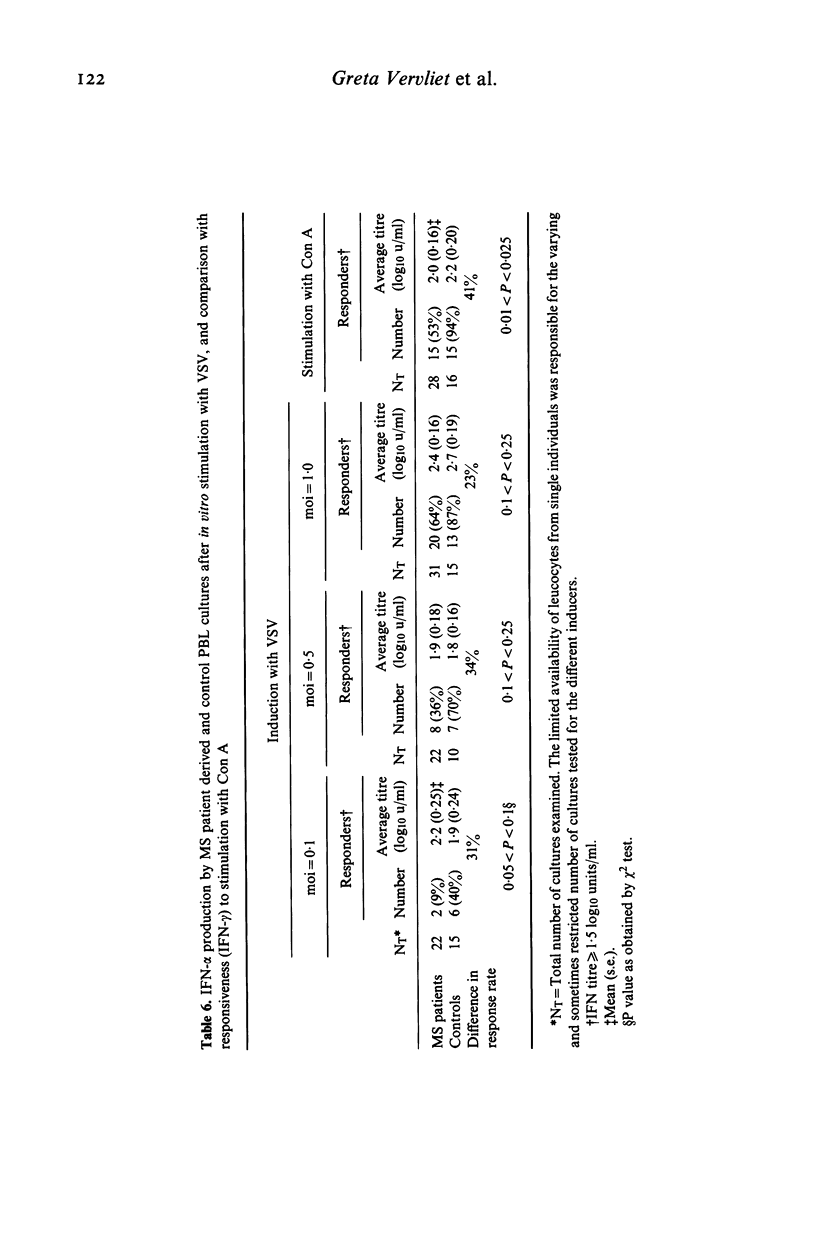
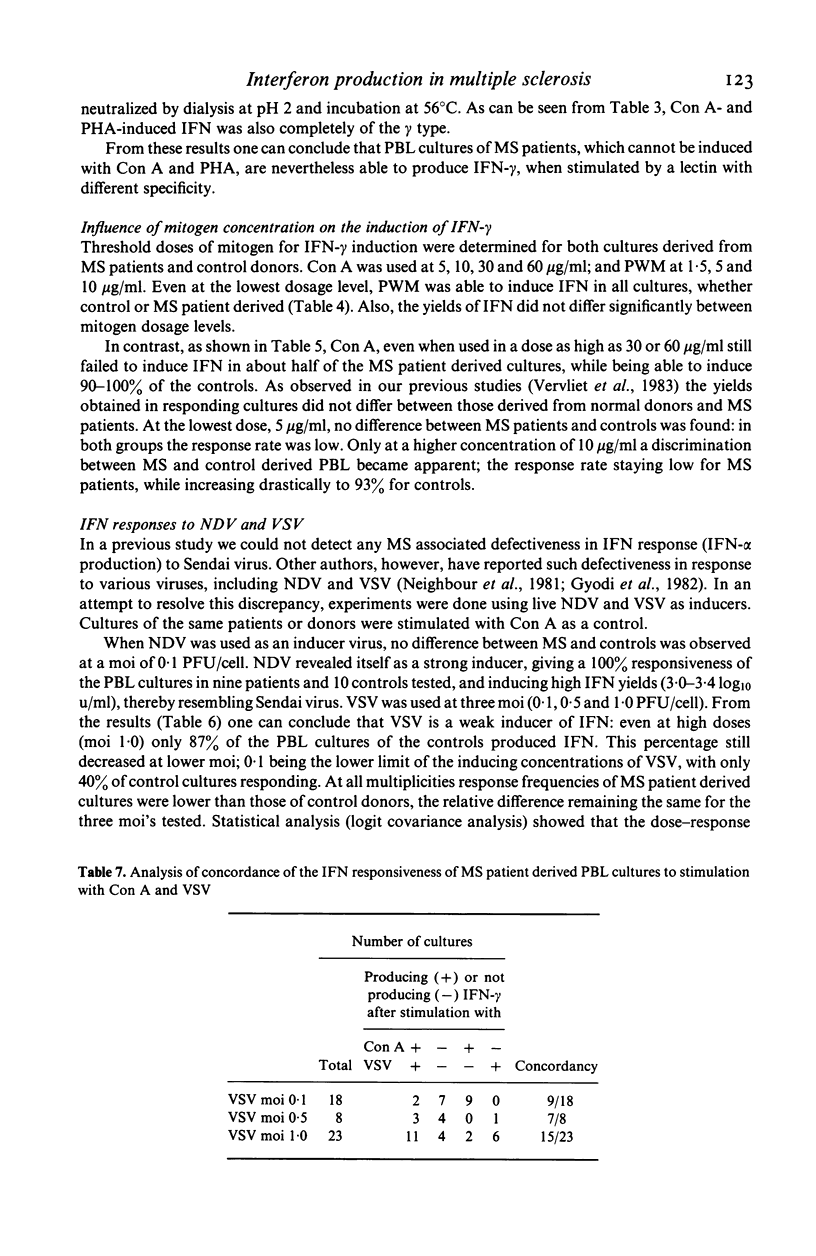
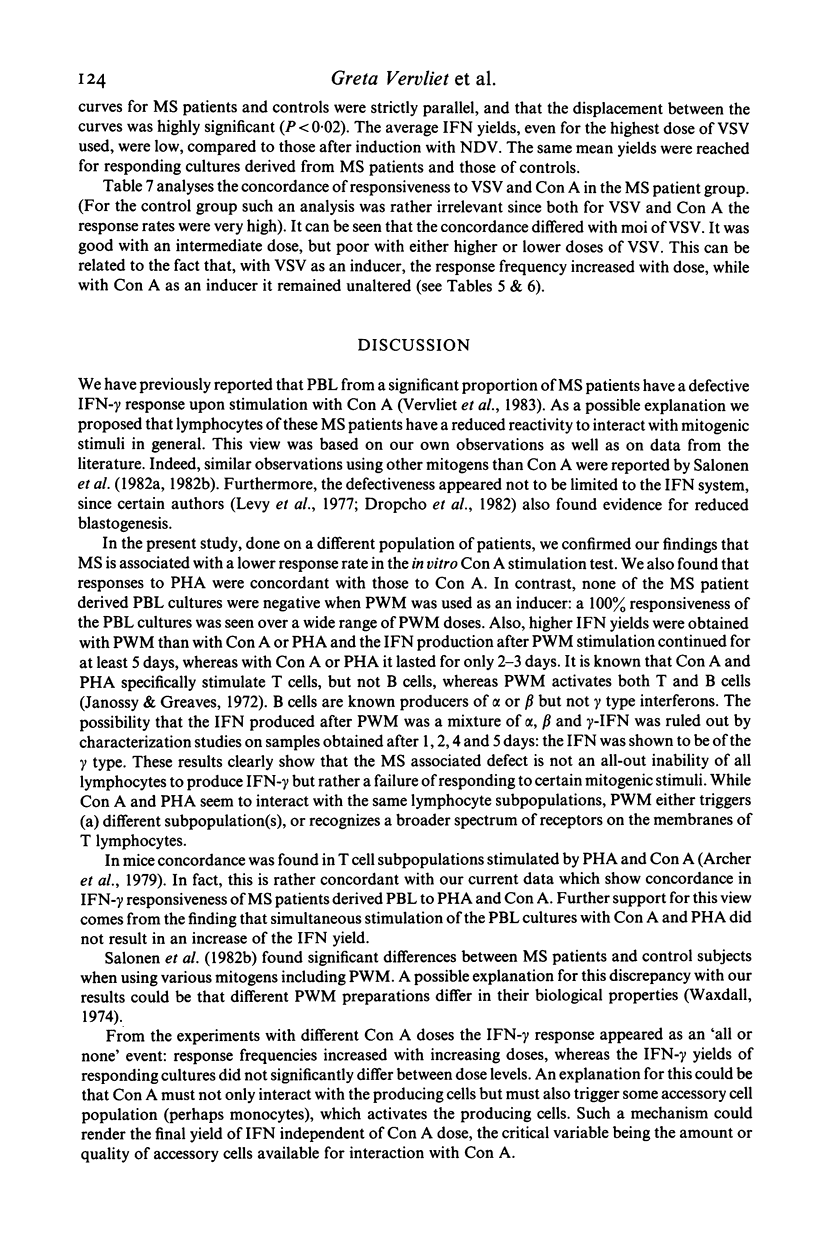
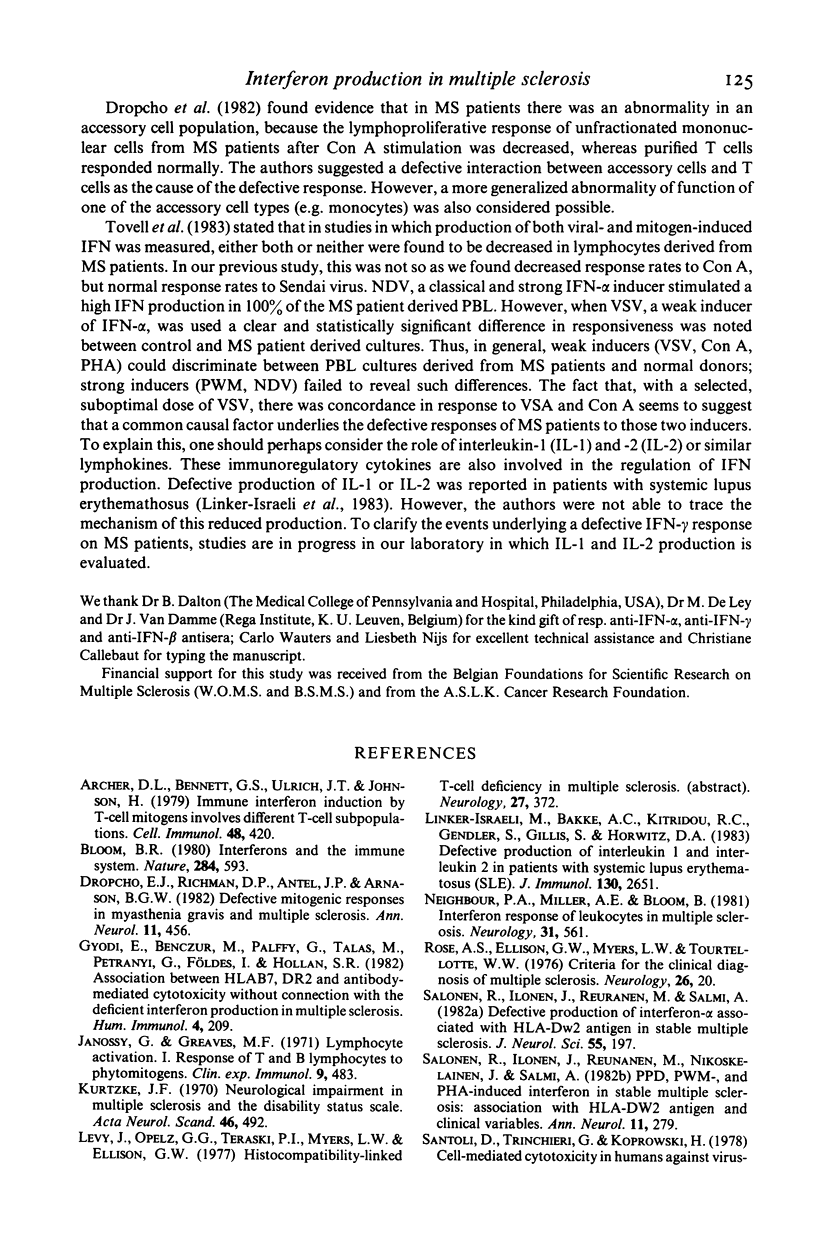
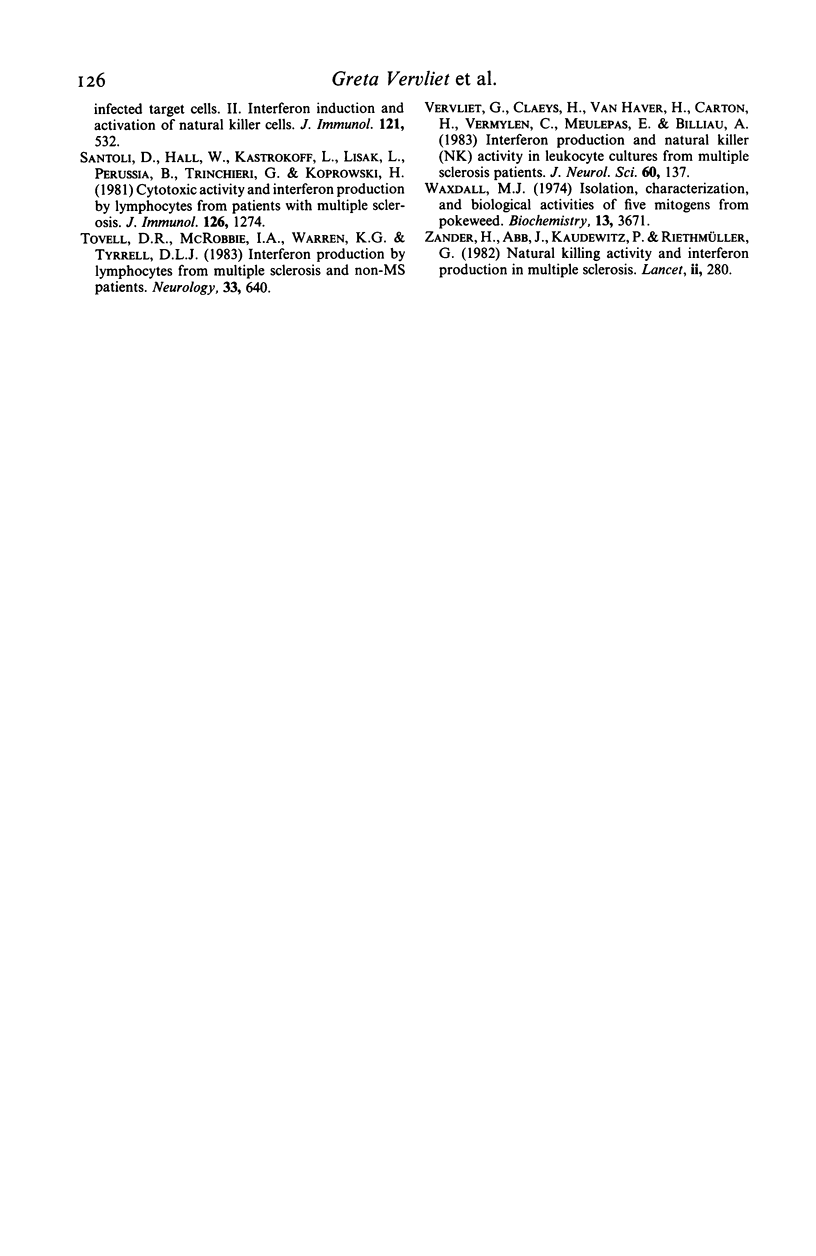
Selected References
These references are in PubMed. This may not be the complete list of references from this article.
- Archer D. L., Smith B. G., Ulrich J. T., Johnson H. M. Immune interferon induction by T-cell mitogens involves different T-cell subpopulations. Cell Immunol. 1979 Dec;48(2):420–426. doi: 10.1016/0008-8749(79)90137-0. [DOI] [PubMed] [Google Scholar]
- Bloom B. R. Interferons and the immune system. Nature. 1980 Apr 17;284(5757):593–595. doi: 10.1038/284593a0. [DOI] [PubMed] [Google Scholar]
- Dropcho E. J., Richman D. P., Antel J. P., Arnason B. G. Defective mitogenic responses in myasthenia gravis and multiple sclerosis. Ann Neurol. 1982 May;11(5):456–462. doi: 10.1002/ana.410110504. [DOI] [PubMed] [Google Scholar]
- Gyódi E., Benczur M., Pálffy G., Tálas M., Petrányi G., Földes I., Hollán S. R. Association between HLA B7, DR2 and dysfunction of natural- and antibody-mediated cytotoxicity without connection with the deficient interferon production in multiple sclerosis. Hum Immunol. 1982 Jun;4(3):209–217. doi: 10.1016/0198-8859(82)90036-2. [DOI] [PubMed] [Google Scholar]
- Janossy G., Greaves M. F. Lymphocyte activation. I. Response of T and B lymphocytes to phytomitogens. Clin Exp Immunol. 1971 Oct;9(4):483–498. [PMC free article] [PubMed] [Google Scholar]
- Linker-Israeli M., Bakke A. C., Kitridou R. C., Gendler S., Gillis S., Horwitz D. A. Defective production of interleukin 1 and interleukin 2 in patients with systemic lupus erythematosus (SLE). J Immunol. 1983 Jun;130(6):2651–2655. [PubMed] [Google Scholar]
- Neighbour P. A., Miller A. E., Bloom B. R. Interferon responses of leukocytes in multiple sclerosis. Neurology. 1981 May;31(5):561–566. doi: 10.1212/wnl.31.5.561. [DOI] [PubMed] [Google Scholar]
- Rose A. S., Ellison G. W., Myers L. W., Tourtellotte W. W. Criteria for the clinical diagnosis of multiple sclerosis. Neurology. 1976 Jun;26(6 Pt 2):20–22. doi: 10.1212/wnl.26.6_part_2.20. [DOI] [PubMed] [Google Scholar]
- Salonen R., Ilonen J., Reunanen M., Nikoskelainen J., Salmi A. PPD-, PWM-, and PHA-induced interferon in stable multiple sclerosis: association with HLA-Dw2 antigen and clinical variables. Ann Neurol. 1982 Mar;11(3):279–284. doi: 10.1002/ana.410110308. [DOI] [PubMed] [Google Scholar]
- Salonen R., Ilonen J., Reunanen M., Salmi A. Defective production of interferon-alpha associated with HLA-DW2 antigen in stable multiple sclerosis. J Neurol Sci. 1982 Aug;55(2):197–206. doi: 10.1016/0022-510x(82)90101-0. [DOI] [PubMed] [Google Scholar]
- Santoli D., Hall W., Kastrukoff L., Lisak R. P., Perussia B., Trinchieri G., Koprowski H. Cytotoxic activity and interferon production by lymphocytes from patients with multiple sclerosis. J Immunol. 1981 Apr;126(4):1274–1278. [PubMed] [Google Scholar]
- Santoli D., Trinchieri G., Koprowski H. Cell-mediated cytotoxicity against virus-infected target cells in humans. II. Interferon induction and activation of natural killer cells. J Immunol. 1978 Aug;121(2):532–538. [PubMed] [Google Scholar]
- Tovell D. R., McRobbie I. A., Warren K. G., Tyrrell D. L. Interferon production by lymphocytes from multiple sclerosis and non-MS patients. Neurology. 1983 May;33(5):640–643. doi: 10.1212/wnl.33.5.640. [DOI] [PubMed] [Google Scholar]
- Vervliet G., Claeys H., Van Haver H., Carton H., Vermylen C., Meulepas E., Billiau A. Interferon production and natural killer (NK) activity in leukocyte cultures from multiple sclerosis patients. J Neurol Sci. 1983 Jul;60(1):137–150. doi: 10.1016/0022-510x(83)90133-8. [DOI] [PubMed] [Google Scholar]
- Waxdal M. J. Isolation, characterization, and biological activities of five mitogens from pokeweed. Biochemistry. 1974 Aug 27;13(18):3671–3677. doi: 10.1021/bi00715a008. [DOI] [PubMed] [Google Scholar]
- Zander H., Abb J., Kaudewitz P., Riethmüller G. Natural killing activity and interferon production in multiple sclerosis. Lancet. 1982 Jan 30;1(8266):280–280. doi: 10.1016/s0140-6736(82)91001-7. [DOI] [PubMed] [Google Scholar]


